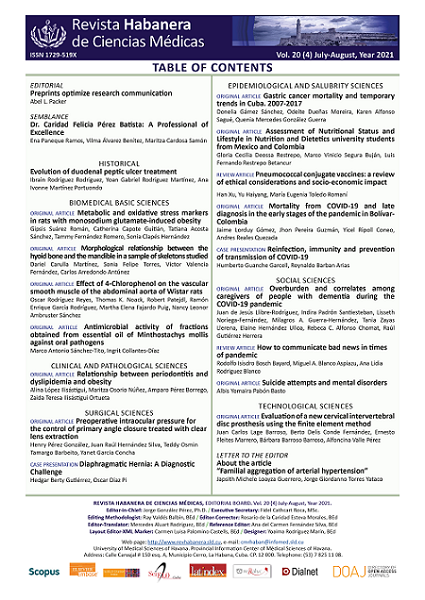Antimicrobial activity of fractions obtained from essential oil of Minthostachys mollis against oral pathogens
Keywords:
Essential oil, chemical composition, fractionation, antibacterial agents.Abstract
Introduction: The essential oil of Minthostachys mollis has demonstrated to have important antimicrobial properties.
Objective: To chemically characterize the fractions obtained from the essential oil of Minthostachys mollis and to evaluate the antimicrobial activity against Streptococcus mutans, Lactobacillus acidophilus, Enterococcus faecalis, Porphyromonas gingivalis and Candida albicans.
Material and Methods: The petroleum ether, dichloromethane and methanol fractions of the AE of M. mollis were chemically characterized by gas chromatography coupled to mass spectrometry. The repetitions of the antimicrobial test were calculated using the EPIDAT v.4.2 program. The antimicrobial activity was performed by the disk diffusion method and the minimum inhibitory concentration was calculated by the microdilution method. The data were analyzed using the ANOVA test (p=0.05).
Results: The main constituents of the petroleum ether, dichloromethane and methanol fractions were cis-Menthone (39,8 %), thymol (31,2 %) and α-Terpineol (43,6 %), respectively. All strains were sensitive to the three fractions, although C. albicans was the most sensitive strain, registering inhibition halos of 14,73±0.57 mm for the methanol fraction, 20,91±0.55 mm for petroleum ether and 20.38±0.58 mm for dichloromethane, finding significant differences when compared to 0,12 % Chlorhexidine and Nystatin (p<0,05). The minimum inhibitory concentrations of the fractions ranged from 0,2 to 3,2 µg/mL.
Conclusions: The main constituents of the petroleum ether, dichloromethane and methanol fractions were cis-Menthone, thymol and α-Terpineol. The petroleum ether and dichloromethane fractions were highly effective in inhibiting the growth of S. mutans, L. acidophilus, E. faecalis, P. gingivalis, and C. albicans.Downloads
References
1. Valenzuela Oré F, Romaní Romaní F, Monteza Facho BM, Fuentes Delgado D, Vilchez Buitron E, Salaverry García O. Prácticas culturales vinculadas al cuidado de la salud y percepción sobre la atención en establecimientos de salud en residentes de centros poblados alto-andinos de Huancavelica, Perú. Rev Peru Med Exp Salud Publica [Internet]. 2018 [Citado 10/08/2020];35(1):84-92. Disponible en: https://doi:10.17843/rpmesp.2018.351.3603
2. De la Cruz H, Vilcapoma G, Zevallos PA. Ethnobotanical study of medicinal plants used by the Andean people of Canta, Lima, Peru. J Ethnopharmacol [Internet]. 2007 [Citado 10/09/2020];111(2):284-94. Disponible en: https://doi:10.1016/j.jep.2006.11.018
3.Lock O, Perez E, Villar M, Flores D, Rojas R. Bioactive compounds from plants used in peruvian traditional medicine. Nat Prod Commun [Internet]. 2016 [Citado 10/09/2020];11(3):315-37. Disponible en: https://pubmed.ncbi.nlm.nih.gov/27169179/
4. De la Cruz MG, Malpartida SB, Santiafo HB, Jullian V, Bourdy G. Hot and cold: medicinal plant uses in Quechua speaking communities in the high Andes (Callejón de Huaylas, Ancash, Perú). J Ethnopharmacol [Internet]. 2014 [Citado 10/09/2020];155(2):1093-117. Disponible en: https://doi:10.1016/j.jep.2014.06.042
5. Dhifi W, Bellili S, Jazi S, Bahloul N, Mnif W. Essential oils' chemical characterization and investigation of some biological activities: A critical review. Medicines (Basel) [Internet]. 2016 [Citado 10/08/2020];3(4):25. Disponible en: https://doi:10.3390/medicines3040025
6. Torrenegra Alarcón M, Granados Conde C, Durán Lengua M, León Méndez G, Yáñez Rueda X, Martínez C, et al. Composición química y actividad antibacteriana del aceite esencial de Minthostachys mollis. Orinoquia [Internet]. 2016 [Citado 10/09/2020];20(1):69-74. Disponible en: http://www.scielo.org.co/scielo.php?pid=S0121-37092016000100008&script=sci_abstract&tlng=es
7.Cano C, Bonilla P, Roque M, Ruiz J. In vitro antifungal activity and metabolites of the essential oil of the leaves of Minthostachys mollis (muña) leaves. Rev Peru Med Exp Salud Pública [Internet]. 2008 [Citado 10/09/2020];25(3):298-301. Disponible en: http://www.scielo.org.pe/scielo.php?pid=S1726-46342008000300008&script=sci_abstract&tlng=en
8. Campo FM, Ambuludí FDL, Cepeda RNC, Márquez HI, San Martín GD, Cuesta RO. Composición química y actividad antibacteriana del aceite esencial de Minthostachys mollis Griseb contra el Staphylococcus aureus. Rev Cubana Farm [Internet]. 2019 [Citado 10/09/2020];51(4):[Aprox. 2 p.]. Disponible en: http://www.revfarmacia.sld.cu/index.php/far/article/view/183/175
9. Peña SD, Gutiérrez RM. Efecto antimicrobiano del aceite esencial de Minthostachys mollis sobre microorganismos frecuentes en vías respiratorias bajas. Revista Ciencia y Tecnología [Internet]. 2017 [Citado 10/09/2020];13(3):55-66. Disponible en: https://revistas.unitru.edu.pe/index.php/PGM/article/view/1874/1802
10. Benites J, Guerrero Castilla A, Salas F, Martinez JL, Jara Aguilar R, Venegas Casanova EA, et al. Chemical composition, in vitro cytotoxic and antioxidant activities of the essential oil Peruvian Minthostachys mollis Griseb. Bol Latinoam Caribe Plant Med Aromat [Internet]. 2018 [Citado 10/09/2020];17:566-74. Disponible en: https://revistaschilenas.uchile.cl/handle/2250/34890
11. Pandey AK, Kumar P, Singh P, Tripathi NN, Bajpai VK. Essential Oils: Sources of antimicrobials and food preservatives. Front Microbiol [Internet]. 2017 [Citado 10/09/2020];7:2161. Disponible en: https://doi:10.3389/fmicb.2016.02161
12. Díaz LK, Moromi NH. Determinación antibacteriana in vitro de Menthostachys mollis (Muña) frente a bacterias orales de importancia estomatológica. Odonto Sanmarquina [Internet]. 2005 [Citado 10/09/2020];8(2):3-5. Disponible en: https://revistasinvestigacion.unmsm.edu.pe/index.php/odont/article/view/3137
13. Aguilar Ancori EG, Aguilar Ancori KV, Garay B, Mamani V, Quispe Flórez MM. Actividad antibacteriana frente a Streptococcus mutans de aceites esenciales de cinco plantas alto andinas. Rev Peru Med Exp Salud Publica [Internet]. 2018 [Citado 10/09/2020];35(1):161-3. Disponible en: https://doi:10.17843/rpmesp.2018.351.3610
14. Aigaje Sierra AI, Zurita Solís MK. Efectividad antimicrobiana del aceite esencial de Minthostachys mollis (tipo) al 25, 50, 100 % frente a Porphyromonas gingivalis. Dom Cien [Internet]. 2017 [Citado 10/09/2020];3(1):3-20. Disponible en: https://dialnet.unirioja.es/servlet/articulo?codigo=5802909
15. Cornejo Ulloa P, van der Veen MH, Krom BP. Review: modulation of the oral microbiome by the host to promote ecological balance. Odontology [Internet]. 2019 [Citado 10/09/2020];107(4):437-48. Disponible en: https://doi.org/10.1007/s10266-019-00413-x
16. Oz M, Lozon Y, Sultan A, Yang KHS, Galadari S. Effects of monoterpenes on ion channels of excitable cells. Pharmacol Ther [Internet].2015 [Citado 10/09/2020];152:83-97. Disponible en: https://doi.org/10.1016/j.pharmthera.2015.05.006
17. Guimarães AC, Meireles LM, Lemos MF, Guimarães MC, Endringer DC, Fronza M, et al. Antibacterial activity of terpenes and terpenoids present in essential oils. Molecules [Internet]. 2019 [Citado 10/09/2020];24(13):2471. Disponible en: https://doi.org/10.3390/molecules24132471
18. Almedia RN, Soares RP, Cassel E. Fractionation process of essential oils by batch distillation. Braz J Chem Eng [Internet]. 2018 [Citado 10/09/2020];35(3):1129-40. Disponible en: http://www.scielo.br/scielo.php?script=sci_arttext&pid=S0104-66322018000301129&lng=en&nrm=iso
19. Silvestre WP, Medeiros FR, Agostini F, Toss D, Pauletti GF. Fractionation of rosemary (Rosmarinus officinalis L.) essential oil using vacuum fractional distillation. J Food Sci Technol [Internet]. 2019 [Citado 10/09/2020];56, 5422-34. Disponible en: https://doi.org/10.1007/s13197-019-04013-z
20. Hendry ER, Worthington T, Conway BR, Lambert PA. Antimicrobial efficacy of eucalyptus oil and 1,8-cineole alone and in combination with chlorhexidine digluconate against microorganisms grown in planktonic and biofilm cultures. J Antimicrob Chemother [Internet]. 2009 [Citado 10/09/2020];64(6):1219-25. Disponible en: https://doi.org/10.1093/jac/dkp362



